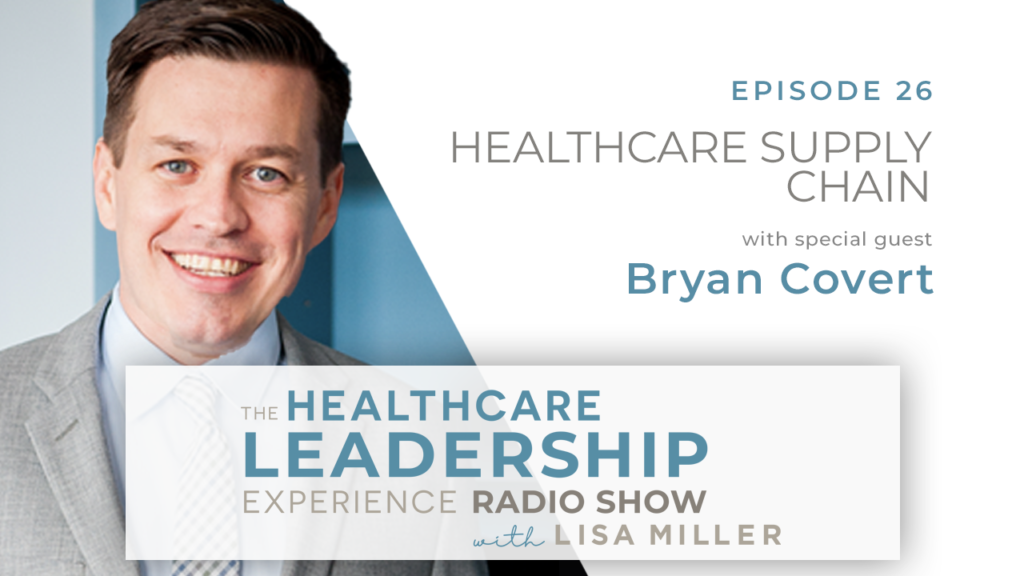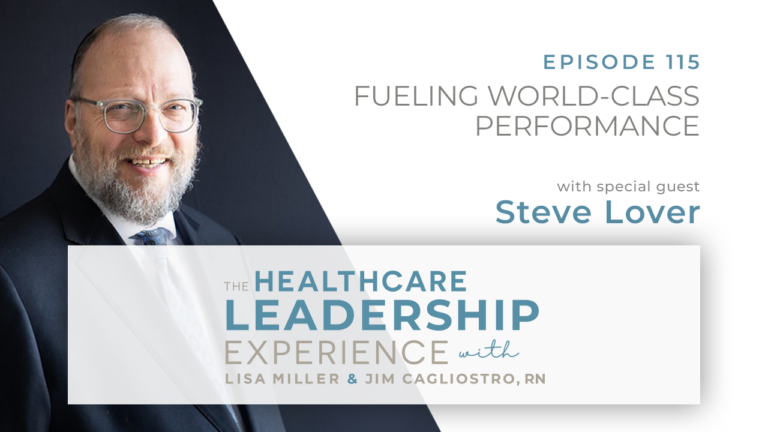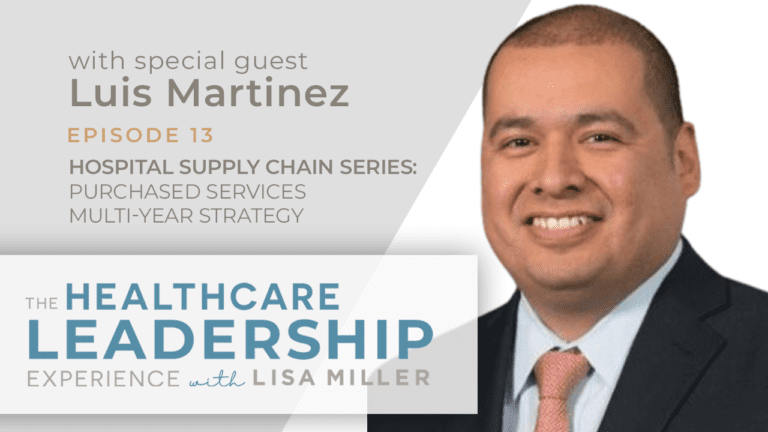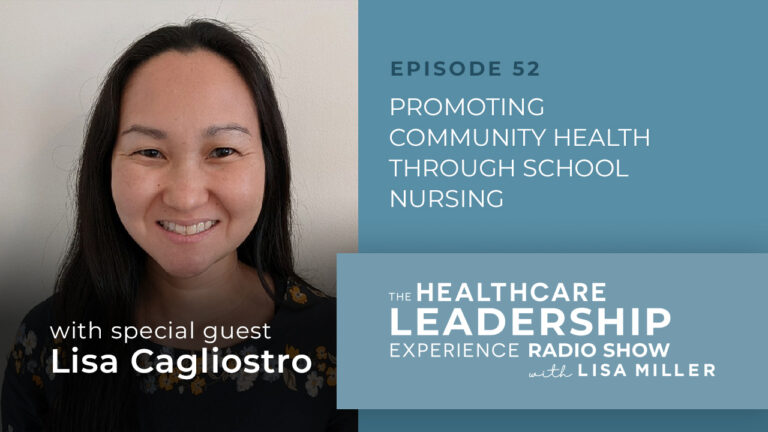In Episode 26 of The Healthcare Leadership Experience, Lisa is joined by Bryan Covert from VIE Healthcare to discuss hospital supply chain and predicted trends for 2022.
As Bryan comments: ‘’Now more than ever, supply chain …needs executive support to be successful. And executives need to be paying attention and supporting supply chains so that they can work throughout the organization.’’
This episode is sponsored by VIE Healthcare Consulting® which has proudly helped hospitals save $772 million since 1999.
In today’s episode you’ll hear:
How the pandemic has shown why outsourcing, or reliance on one source to meet your supply chain requirements, is not a sustainable strategy. ‘’As everyone has heard me say, we can’t have an over reliance on one aspect, one strategy. Remember, GPOs are an outsourced provider of services, so, ….their agreements, their services, they also need to be analyzed.’’
Why every hospital needs to build a strong team post-pandemic – and why healthcare leaders need to pay close attention to supply chain. Hint: The potential ROI for investment in supply chain is as high as 100-1.
The key trends affecting healthcare supply chain as we move into 2022, including:
- High inflation.
- Constraints on raw materials.
- Difficulties in hiring.
…and why hospitals need to be aware of how vendors will use this narrative to raise their costs. ‘’A lot of the effort now is going to be around controlling costs, and finding those areas where you can lower costs.’’
The importance of spend analytics for hospitals and the cost savings available in the line-item details of your purchased services spend.
Three pro-active steps supply chain leaders can take right now – and why every hospital needs to review physician subsidy agreements while revenues are lower, regardless of expiration dates. ‘’Just because collections are down, that doesn’t mean the hospital should pay more.’’
Why 2022 will see supply chain move ‘’out of the basement’’ to become a central operational pillar for every health system.
For more on purchased services, listen again to Episode 25 of The Healthcare Leadership Experience.
CLICK HERE TO DOWNLOAD THE PDF TRANSCRIPT
Connect with Lisa:
📧 lmiller@spendmend.com
📱https://www.linkedin.com/in/lisamiller/
CLICK HERE TO OPEN THE FULL TRANSCRIPT
Bryan Covert (00:00): We know how valuable supply chain here is at VIE, and executives are really being shown that now with the pandemic, with all the challenges, with costs rising, and labor and [inaudible 00:00:10] materials. Now more than ever, supply chain really needs executive support to be successful. And executives need to be paying attention and supporting supply chains so that they can work throughout the organization. Historically in healthcare, there’s been a lot of silos in contracting that have been kind of outside the reach of supply chain, looking at agreements for physician services, IT agreements, agreements in administration, just some of the examples. And really, people are starting to see how much value a strong supply chain team brings to the table, and in order for them to really be leverage throughout the organization, they need that executive support. Speaker 2 (00:51): Welcome to the Healthcare Leadership Experience, a place where healthcare leaders will share proven strategies and innovative approaches to leading the clinical and business side of healthcare. This show is sponsored by VIE Healthcare Consulting, who’s proudly helped hospitals save over $700 million in non-labor costs since 1999. Here’s you host, Lisa Miller, founder and CEO of VIE Healthcare. Lisa Miller (01:14): Hi, welcome to the Healthcare Leadership Experience. I’m Lisa Miller, and today we’re going to be speaking about the healthcare supply chain, and we have Bryan Covert, who is our managing director here at VIE Healthcare, joining us. Welcome, Bryan. Bryan Covert (01:29): Thank you for having me. Lisa Miller (01:31): And, of course, we have our producer Lisa Larter. Lisa, thank you for being here today. Lisa Larter (01:36): Hey, my pleasure. Good to be here. Good to see you, Bryan. Bryan Covert (01:39): You too, Lisa. Lisa Miller (01:40): So today we’re going to be speaking about the healthcare supply chain and some trends to be considering as we go into 2022. And really, you know, we’re proactive on aspects that are going to be important as we go into a new year with, unfortunately, continuing some challenges with the pandemic, and now with supply chain. But I wanna just take a step back before I ask Bryan some questions. And the one area that I think has been a- a positive that h- has come out of, um, the pandemic is that I’m seeing, across the country, supply chain leaders and leaders within the hospital building their supply chain. And here’s what I have seen in previous years that was concerning, supply chain departments that were outsourced to companies, or aspects that were outsourced to GPOs, or such a over reliance on GPOs, which then caused hospitals to take away FTEs from the supply chain department. You know, GPOs have a place in our ecosystem, however, as everyone has heard me say, we can’t have an over reliance on one aspect, one strategy. Remember, GPOs are an outsource provider of services, so, you know, their agreements, their services, they also need to be analyzed. So when we have an over reliance on GPOs, what had ended up happening is that these departments were, uh, were stripped, you know. They were really taken down to the bare bones. And what we need are departments that are strong, that we need to invest in supply chain. We need to build great supply chain departments because that investment and that ROI will be enormous. It’ll be a 50-1, 100-1 ROI. Building capabilities, having a- a strong, diverse team, and those capabilities include, you know, highly skilled strategic sourcing, logistics, uh, you know, critical thinking, [inaudible 00:03:55], analytics. But having a really strong team, bench, uh, and building that bench, you know, looking for the future leaders. So I have seen our clients are investing in adding to the supply chain and really critical, strategic positions in the supply chain. I’m so happy to see that. You know, we’ve been able to support a lot of those hospitals, and helping with training programs or analytics, or just helping build their team. I’ve a- always said it, when I started the company 22 years ago, our job is to support supply chain, support departments, make them better and increase their skills. Because that will help the hospital. Offering to outsource the department, offering to, um, take the department down to bare bones and- and rely on the GPO services, those are things that are not sustainable. And we saw that during the pandemic. And now, post- you know, really the initial shock of the pandemic, as we are catching up, although still in it. Hospitals are building their supply chain. And I think it’s going to have a remarkable impact on the bottom line for those hospitals that have decided that their supply chain needs to be critical thinkers. “Should this be part of a GPO agreement? Should we look at off contracts [inaudible 00:05:19]? Wait a minute, we have backorders. We- we’re gonna need to be proactive. How are we going to be anticipatory? You know, how do we manage inventory?” And I am so proud of, uh, the organizations that have now invested money in their supply chain. I think that’s been a positive… I know a long intro, but I say, you know, we should be doing more of that. The value of that in- increasing your team members on the supply chain will be just tremendous. So, Bryan, couple of questions for you. Why should healthcare executives be paying super close attention to supply chain right now? Bryan Covert (05:59): Thank you, Lisa. That is a great intro, um, you touched on a lot of important topics there. And we always felt like supply chain and we know how valuable supply chain here is at VIE. And executives are really being shown that now with the pandemic, with all the challenges, with costs rising, and labor and [inaudible 00:06:17] materials. Now more than ever, supply chain really needs executive support to be successful. And executives need to be paying attention and supporting supply chains so that they can work throughout the organization. Historically in healthcare, there’s been a lot of silos in contracting that have been kind of outside the reach of supply chain, looking at agreements for physician services, IT agreements, agreements in administration, just some of the examples. And really, people are starting to see how much value a strong supply chain team brings to the table, and in order for them to really be leverage throughout the organization, they need that executive support. Lisa Miller (06:55): Absolutely. You know, I think there’s another addition to why it’s so important because if you think about how much costs go through the supply chain, and there’s lots of things to pay attention to, and whether that’s infusing technology, automation, just different strategies to get a handle on just not cost and pricing, but maybe inventory. You know, looking at engaging clinicians. [inaudible 00:07:22] really important that supply chain has this direct connection to clinicians to have great conversations. And what’s that data flow look like? Clinicians could be nurses on the floor, you know, they’re very protective about supplies and their patients, for good reason, they have to trust inventory levels. And if they don’t trust that, of course, we know that they’re going to find a way to make sure they have their supplies, and kinda hide them on us. So of those conversations with clinicians, you’ve worked on some really interesting projects with analyzing inventory, you know, ABCD inventory, and being able to track that on different floors, as a good way to show nurses, you know, why they can have supplemental stock, you know, not on the floor, and they can trust the data. So, you know, a- and as well as having those conversations with physicians. How do you infuse physician conversations in [inaudible 00:08:16] data or, um, new products or value analysis, all those aspects? How is that strategy for supply chain being executed? And there’s so many aspects… I actually think that, you know, whether you can whiteboard it, or you could do some kind of mind map of it. But if you really sat down and drew a supply chain in the middle and had those arms layered out, you’d see so many aspects. And so those arms could be, you know, whether it’s [inaudible 00:08:43] or managing to spend to position clinician contact, and then developing those strategies like that. I think it’s a lot bigger of a topic, and… you know, as well as everyone on this podcast knows. Bryan, what are some of the trends that executives need to be aware of and concerned about? Bryan Covert (09:01): There’s a number of trends right now. First and foremost on everybody’s mind is the high inflation, constraints on raw materials, difficulties hiring. All of these things are happening right now, and vendors are gonna use this narrative to raise costs, whether it’s warranted or not warranted. a lot of the effort now is gonna be around controlling costs, and trying to find those areas where you can lower costs. Another thing that really came to the forefront, you know, during COVID, and the trend now is organizations being more aware of secondary inventory sources, managing inventory. A lot of organizations had done a really great job driving down costs by relying on just-in-time inventory, using large vendor commitments, sole source vendors, and a lot of these organizations that follow this strategy had difficulty getting supplies during the pandemic ’cause they’re too reliant on one source. They’re too reliant on the inventory coming in that day. So it’s really making a lot of organizations kinda take a step back and say, you know, “What are secondary sources for these products that we need everyday? What do we do in case of emergency? How do we keep everything running?” The last trend that’s really just, started well before the pandemic and just continues, is consolidation. Uh, these successful healthcare organizations are expanding, they’re purchasing new hospitals, they’re growing their footprint, and then the pressure to execute and be successful, a big portion of that falls on the supply chain. When you’re taking in the- an existing hospital, you’re taking on all of their agreements, all of their practices. And then supply chain is really critical to bringing that into your organization and make sure these things are successful, and looking for areas you could standardize and improve. Departments really, you know, are a lot of pressured to do this and do this successfully, and that’s where now there’s a lot of push toward looking for technological solutions, working with partners, anything that’s gonna drive efficiency. But there remains a need for the- a strong supply chain team to get this executed because those technological solutions are only gonna bring you so far. Lisa Miller (11:01): No, it’s true. And, you know, love technology, right. I mean, we have our own patented technology that extracts the invoice line and details from purchase services invoicing, and analyzes them [inaudible 00:11:14], right, and provides this great [inaudible 00:11:17] map by a spend map. So, you know, we love technology, however, you know, there is this aspect of technology that either doesn’t get used or is underutilized, or over utilized too, because people obviously have to do the thinking. There’s always the thinking person behind data and analytics. Which brings me to this really important topic of s- spend analytics. And, you know, I feel like that’s a big opportunity for hospitals, and supply chain is their spend analytics capabilities, right. And their spend analytics capabilities isn’t a dashboard, isn’t Tableau, Power BI, or any other kind of BPO dashboard. Spend analytics is really platform neutral because it could be done in Excel or Access, but spend analytics is a thinking- it’s the structure, it’s what things you wanna look at as a hospital. Does your spend analytics platform or your spend analytics focus around physician preference items? And are you tracking by physician, are you tracking by implant? Is it… How are you tracking purchase services? By line item detail or physician subsidy requests or the renewals or year over year increases, month to month over increases. I think the biggest opportunity and the biggest growth for supply chain in healthcare is building a really solid spend analytics capability. And you can get help for that… you know, we help a lot of hospitals with spend analytics, or we’re pushing that out, but they’re making the decision, they’re doing the thinking. You know, we can contribute some of our thoughts, but we’re just doing the roll-up-your-sleeve, time consuming work, and then we push it out to the hospitals, and now they’re able to have the spend analytics in front of them so they can make those decisions. They’re not spending time in that data wrangling, you know, pulling disparate data together, right. We’re giving them those- the opportunities. So I think that’s a really great opportunity for hospitals to really think about, to plan, is your spend analytics strategy. [inaudible 00:13:28] What is your spend analytics strategy? So, other than that, Bryan, I- what do you think are three proactive things that hospitals should be doing in regards for supply chain? Bryan Covert (13:41): I think number one is just organization. Making sure that you have that analytics platform in place, that you understand the key components of your agreements, where you’re spending money, and where you can improve, you know. Working with a partner could really help categorizing, prioritizing your spend, getting that structure in place. And then the next part would be using that organization to be proact. Not just coming up and analyzing agreements when they’re up for term, but really evaluating where you’re spending money, where the market’s changing, and where you have opportunities. I thought you made a great point, Lisa, when you just talked about it’s an area where a lot of people aren’t focused, especially in supply chain, but physician subsidy. So one of the big impacts of COVID has been decline in elective procedures, decline in revenue, and a lot of these physician subsidy agreements really push the risk of collections back onto the hospital. So regardless whether they’re coming up for expiration or not, agreements like this that push risk back to the hospital need to be evaluated because just ’cause collections are down, that doesn’t mean the hospital should just pay more. There could be opportunities to right size those agreements, right size the utilization, maybe change the staffing model or the hours of operation of those services, and reduce cost that way. Other areas that are really impacted by that are areas where you’ve outsourced services with labor, and they’re responsible for hiring. So looking at EBS or food services, it- it’s been a major strategy of these vendors to kind of establish a fixed price that saves the hospital money, and then the vendors actually take on the risk of- of lowering costs. But now with all the challenges, what’s happening when they can’t fill positions at the rates that were agreed upon three years ago? You just have vacant positions? Are you getting a reduced service? So you need to be proactive in your agreements once you have this organized, and realize where are your opportunities, and with the services you’re getting, are you getting the quality service that you were promised? And has that been impacted and your vendor’s ability to provide that been impacted by the new challenges of today? So once you have those done, you really need to have a good organizational strategy, develop your cost savings pipeline, and you really need to be results focused, not just in your clinical agreements, but also in your purchase service agreements. Make sure you have KPIs that ensure you’re gonna get the quality, and you’re not just focused on costs because that’s gonna be important now moving forward more than ever. Lisa Miller (16:08): Absolutely. One of the things that you do for us and our clients [inaudible 00:16:12] you, in particular, and I think VIE, is you will take med surg distribution spend, which is usually a very messy, a lot of work, complex kinda area spend. There’s just thousands and thousands of vendors or suppliers in a distribution and setting. And you will go through that and uncover unbelievable amounts of opportunity. So I don’t wanna go into that in… i think that’s a podcast of it’s own. But it’s amazing that you take this big bucket of spend, which could be one of the biggest line item spend per hospital, right, the distribution, and putting supplies through a distributor… again, thousands and thousands of items. And you’ll take that report and you do a number of things. So you’re going to make sure that all the pricing’s right. And, you know, what the interesting thing is a lot of times it’s not. And you uncover big cost savings opportunities in this distribution spend. You’ve uncovered big credits because they’ve fallen off or something has happened. You uncover opportunities for standardization because they could be buying direct and using a distributor, and then other aspects to consolidate or standardize. So can you just talk about that for a minute because I think that’s a great strategy going into 2022. For hospitals to say, “Okay, what’s an initiative we can give one of our team members? Maybe [inaudible 00:17:42] we could help you. But to give one of our team members so that they can really look at this as a spend initiative?” Bryan Covert (17:49): That’s a great point, and that’s one of the areas we always look at. It seems counterintuitive, you know, the cost consultant that you want to look at the med surg distribution report because this is an area where you’re going to have a GPO contract, you’re gonna be getting customer service from your GPO rep, you’re gonna have a med surg distribution rep who’s helping you with this spend, you have materials, there’s a lot of eyes on it. But inevitably, there turns out to be a lot of mistakes here, and a lot of opportunity, especially for organizations that have a lot of physical locations and different accounts. What tends to happen is all of these different eyes that are on this spend really don’t have the same priority of the hospital, which is to get the best possible price. When they look at it they’re- is there a contract, not is there the best contract? And also, does every location pay the same for these items? There’s also really kind of a focus on, when an issue does come up, fixing it, move forward, and then move on with it, and there’s not really a big importance on going back and get it corrected through credits and rebills. And part of the reason is ’cause it’s difficult. When you’re dealing with a manufacturer, you’re- going to a distributor and then you’re buying from them. It’s easier just to get it fixed and move on. Uh, you have to kind of navigate a lot of different components and contract terms to really get at the root of the problem that caused the pricing issue and get it fixed and get it credited. But it’s 100% worth doing and we uncover enormous credits. Just going back 12 months and- and looking through these discrepancies, and looking for purchases that really stick out as not being market competitive through our benchmarking database, flagging them, investigating why they’re not getting competitive pricing, not only getting it fixed moving forward, but getting it fixed moving backwards and getting it checked back at the hospital. Lisa Miller (19:38): And the cost savings, too, you’re uncovering is just amazing. But the downside is this is very time consuming. A worthwhile effort, but it’s very time consuming. Uh, thank you, Bryan. So I hope everyone’s enjoyed this episode. I feel like we could talk so much about the supply chain. We are going to be having some healthcare supply chain leaders come onto the Healthcare Leadership Experience. And we have some interesting leaders outside of healthcare who we are now scheduling and we’ll learn from, you know, some of the Fortune 1000 who are leading supply chains and what they can healthcare, what we can learn from what they’re doing, so we’re real excited about those upcoming podcasts. You know, the other final thought is supply chain is a pillar of the hospital. And I do believe that years ago, you know, supply chain was in the basement, kind of thought of as secondary operation to the organization, not as important as growth or rev cycle or marketing, but now it has been elevated to a pillar of the hospital, which, you know, really… I’ve often said for years, it needs to be. Now we’ve often heard basement to the board room, but I feel like it’s a pillar. And it’s an operational pillar that, as we move into 2022, is going to be probably one of the most important pillars because you’re supplying the patients, you’re supporting the clinicians and the physicians, and they’re also tasked with controlling costs and, you know, being [inaudible 00:21:10] with analytics and inventory. You think about the complexity of the supply chain moving, plies, and coordinating services and equipment, it’s just a massive responsibility. So I personally, and those at VIE, wanna thank the supply chain leaders and the supply chain team members, you know, for a really difficult almost 18 months, and what you’ve been able to accomplish is remarkable. And, you know, we are looking forward to continued great things from supply chain, and, you know, we’re here supporting you in every single way we can. So thank you for listening. Please listen to our episode 25 on prioritizing purchase services, and our next episode with Lisa and I, why your hospital needs a podcast. Thank you, Bryan, for being here. And we will look forward to your feedback and suggestions on future shows. Thank you. Leah (22:04): Hi, this is Leah. You were listening to my mom’s podcast, the Healthcare Leadership Experience. Fernando (22:11): Hi, this is Fernando. If you would like to speak with my mom just email her.











